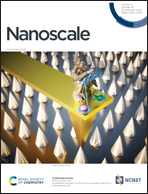Nanoporous platinum needle for cancer tumor destruction by EChT and impedance-based intra-therapeutic monitoring†
Abstract
Herein, we present a new design on the Single Needle Electrochemical Therapy (SNEChT) method by introducing some major improvements, including a nanoporous platinum electrode, tunable in situ anode size that depends on the width and location of the tumor, and the capability of measuring the efficacy of therapy based in intra-therapeutic impedance recording by the same EChT needle. It could have significant implications in optimizing EChT operative conditions. The nanoporous Pt electrode increased the interactive surface with a tumor, and produced a higher amount of current with lower stimulating DC voltage. The tunable anode size prevents the over-acidification of treated or non-desired lesions. Hence, this feature reduced the over distribution of tissue. Monitoring the impedance during the therapy clearly informs us about the local destruction of the tumor in each location. Thus, we can be informed about the threshold of tissue acidosis with the lowest electrical stimulation. The insertion of one needle with a tunable anode length for both precise therapy and impedance-based intra-therapeutic monitoring will shed new light on the applications of EChT.



 Please wait while we load your content...
Please wait while we load your content...